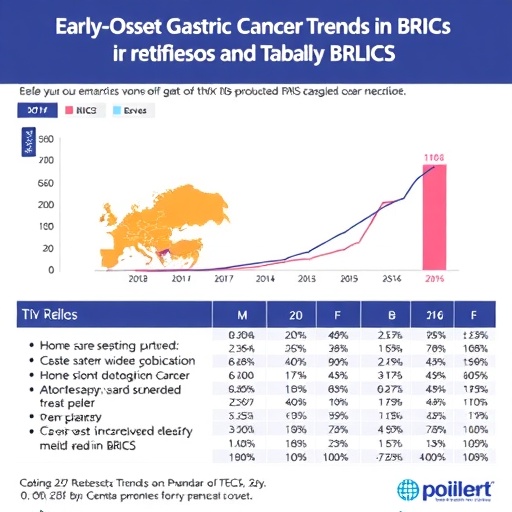
Researchers at the University of Michigan have pioneered a groundbreaking method for detecting circulating tumor cells (CTCs) in the blood of patients suffering from pancreatic and lung cancers. This new technique addresses a critical need in oncology; early detection of these elusive cells can dramatically improve patient outcomes. As tumors progress, they release cells into the bloodstream, significantly complicating the challenge of identifying these malignant cells amidst the billions of normal blood cells.
Recent studies have shown that current methods predominantly rely on labeling specific proteins on the tumor cell surfaces using fluorescent dyes. This approach, while making it easier to spot these cells under a microscope, has notable limitations. Many CTCs lack the specific proteins targeted by these dyes, leading to missed diagnoses. Furthermore, the standard techniques often kill the cells in the process of identification, preventing researchers from further analyzing them or understanding the cancer’s inner mechanisms.
To develop a solution, the research team, led by professor Sunitha Nagrath, sought to utilize biolasers for the identification of viable CTCs. Unlike traditional fluorescent dye methods, this innovative strategy stains the nucleus of the cells, a crucial part of all cells. This crucial change in approach allows for the continued viability of the cancer cells, granting researchers the golden opportunity to conduct detailed investigations after their detection.
The methodology employs a circular maze known as Labyrinth, which selectively isolates circulating tumor cells based on their size; these cells are slightly larger than typical white blood cells. In this setup, CTCs are subject to forces that separate them from smaller cells, akin to how a truck would navigate through a tight curve compared to a bicycle. This physical distinction is instrumental, as it allows the researchers to concentrate on the CTCs in a blood sample before moving on to the next phase of detection.
Once the CTCs have been isolated, they are placed between two mirrors, where they are subjected to an excitation laser that targets them one by one. When the laser intensity reaches a certain threshold, the cells emit their own laser light, transforming into “cell lasers.” This emission is significantly more powerful than the signals obtained through conventional fluorescent techniques, providing clearer and more distinct imagery of the cancer cells. This process allows researchers to glean vital insights into the organization of DNA within cancer cells, illuminating their intrinsic behavior.
The distinct images produced by the cellular laser emissions differ markedly from those captured through fluorescent techniques. While traditional imaging renders cells as glowing spherical blobs, the biolasers produce intricate shapes that reveal critical details about the cells’ internal structures. However, recognizing the complexity of these subtle differences posed a challenge; that’s where advanced machine learning algorithms became invaluable.
The research team employed a model known as the Deep Cell-Laser Classifier, which demonstrated remarkable accuracy in identifying pancreatic cancer cells, achieving a staggering 99% success rate. Even more impressively, this same model could identify lung cancer cells without needing additional training, showcasing its adaptability and robustness across different cancer types. This cross-functionality opens numerous avenues for future research, where one successful model can be leveraged against multiple cancer forms.
As the project progresses, the research team is eager to develop a more sophisticated device that not only detects but also isolates CTCs. The current procedure requires the removal of the top mirror to collect the detected cells, which can inadvertently disturb the process and cause tracking losses. To circumvent this, they envision a system that aligns cells sequentially through the laser’s path, allowing for more streamlined and accurate collection for subsequent analysis.
Moving forward, the team aims to exploit the pattern of light emitted by these cells to assess the aggressiveness of the tumors and understand their treatment responses. The intrinsic variability among circulating cells means that the information gleaned can reflect how different cancer cells respond to various therapeutic cycles, thus providing invaluable data that can influence treatment plans and patient management strategies.
The interdisciplinary nature of this project is a key factor in its success. By combining expertise from engineering, chemistry, and medicine, the research not only tackles a pressing medical issue but also stands as a testament to the power of collaborative science. The Judith Tam ALK Lung Cancer Research Initiative played a vital role in this research, facilitating detailed analyses of patient material, which might not have been possible without such partnerships.
In summary, the development of a deep-learning-assisted biolaser technology marks a significant leap in cancer research. With its potential for non-destructive cell detection and unprecedented accuracy in identifying circulating tumor cells, it paves the way for transformative advances in early cancer diagnosis and personalized medicine. As this research progresses, we are hopeful that it will not only improve survival rates but also lead to more tailored treatment options for patients facing some of the most aggressive forms of cancer.
Subject of Research: Circulating Tumor Cells
Article Title: Antigen-independent single-cell circulating tumor cell detection using deep-learning-assisted biolasers
News Publication Date: 22-Nov-2024
Web References: http://dx.doi.org/10.1016/j.bios.2024.116984
References: Published in Biosensors and Bioelectronics
Image Credits: Credit: Jacob Dwyer, Michigan Medicine
Keywords: Cancer detection, circulating tumor cells, biolasers, machine learning, University of Michigan, pancreatic cancer, lung cancer





